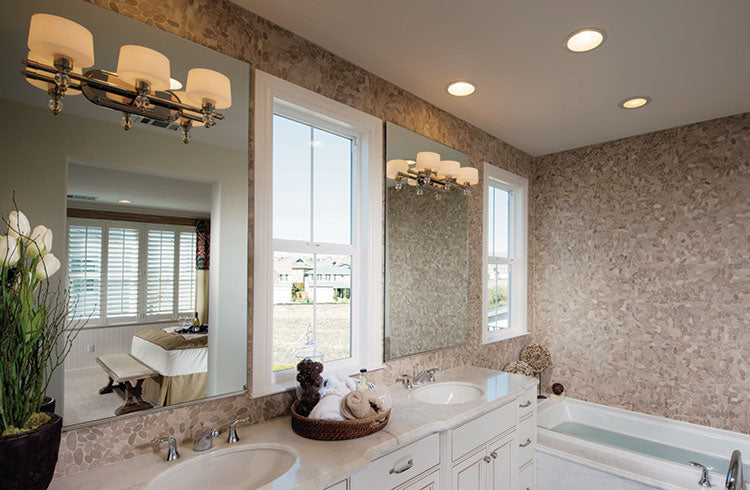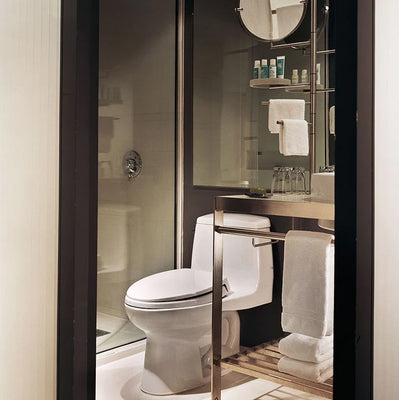Bath
Bathroom Recessed Lighting Placement: Helpful Layout Tips & Tricks
Though understated by design, bathroom recessed lighting can make a big impact. Recessed lights provide the ambient light you need before heading out the door or hitting the hay. They also illuminate design features in your bathroom and prevent shadows in nooks and corners. Read on to learn how to get your recessed lighting placement right in every bathroom of your home.
Note: Always be on the safe side and consult with a certified electrician before trying to install a recessed bathroom light yourself.
What Is the Best Placement for Recessed Lighting in a Bathroom?
The best placement depends on the purpose of the recessed lighting.
- Accent lighting is targeted to brighten décor elements, such as wall art or architectural features. Place recessed lights above the element.
- Task lighting is targeted to illuminate your activities. Place task recessed lighting over the vanity or in the shower. (Note: Light fixtures for showers must be wet-rated.)
- Ambient lighting is usually spread out to mimic natural light. Evenly space ambient recessed fixtures in a line or a grid formation.
Break your bathroom down into zones when designing your layout. You don't use the sink, tub, shower, and toilet all at once in large bathrooms, so you don't need every light on a single switch. For example, you can have a zone over your step-up tub, and another in your vanity, giving you the option to turn one zone on while leaving others off, or keep one zone brighter than the other (when using dimmers).
Bathroom Recessed Lighting Spacing
The guideline for spacing recessed lights in a bathroom: divide the ceiling height by two. For example, in a bathroom with a 9-foot ceiling, place the lights 4.5 feet apart. The layout should provide enough light, without overwhelming the space.
But, remember rules are meant to be broken. You may want to install more fixtures closer together when they are serving as vanity lighting, or set them further apart if you have abundant light sources elsewhere.
What Size Recessed Lights Are Best for Bathrooms?
Different zones in your bathroom will likely call for different size recessed lights, ranging from six inches in diameter (the most common size) to three inches. The smaller size recessed light fixtures are perfect for small bathrooms, or to differentiate zones, such as a changing nook or tub zone. You can select large recessed light fixtures for the main section of master baths and luxury bathrooms.
Recessed Lighting Over the Bathroom Vanity
Recessed lighting can serve as both ambient and task lighting over your vanity.
- Grab the tape measure and pencil. Measure the space above your vanity. For recessed vanities, measure the distance between the two side walls. For open vanities, measure the width of the vanity counter or the mirror. In a large bathroom, it might be five feet across; in a small bathroom, this area may be three feet across. This is the measurement you'll be using to place recessed fixtures in the ceiling.
- Select the number of lights. The number of lights will depend on the above measurement, the size of the recessed light, and the purpose. For ambient light, you may simply use one or two fixtures. For task lighting, you may want to add more. You can fit more small fixtures in the same space, if that's your preference.
- Space the lights evenly. The math here will vary depending on your vanity, and how many lights you are adding. But let's consider a recessed vanity with five feet (60 inches) of ceiling space for recessed lights. If you are adding two lights, place the fixtures 20 inches in from either side for symmetry.
- Move away from the wall. Measure the vanity depth from the wall to the front of the counter and divide in half. The result is the distance the recessed ceiling light should be from the wall.
- Install fill lights. Downlighting by itself can cause shadows and interfere with makeup application; complement your recessed lights with wall sconces or pendants on either side of the sink.
Recessed Fixture Placement for Ambient Light in the Bathroom
Fill your half bath or master bath with natural light from simple, yet elegant recessed lighting:
Keep it simple. For small bathrooms, one sizable recessed light fixture may be enough to distribute abundant light throughout the space. In large bathrooms, consider a line of lights down the middle of the ceiling, or small recessed lighting fixtures around the perimeter.
Create a cohesive style. Recessed light trim comes in more than white. Go a bit bolder and choose fixtures in black, chrome, or brass—just be sure the trim color matches your overall bathroom style and other hardware.
Opt for dimmers. Give yourself the option of full brightness in the morning when you are starting the day, and lower light for your bedtime routine and in the middle of the night.
Recessed Lighting in the Shower
Sometimes your bathroom ceiling lights don't provide enough light in the shower. Low light in the shower isn't a problem with specialty recessed lighting fixtures in the shower ceiling.
Use wet-rated fixtures. For obvious reasons, the recessed fixtures you select for your shower must be safety rated for wet locations. Fixtures with a 'damp' location rating are not sufficient.
Match the number of lights to the size of the shower. One recessed light is enough for smaller showers (3'x3'), but for safety and style, opt for two or more in large or luxury showers.
Deliver light from outside the shower. Position eyeball lights in a line between one and two feet away from the shower and direct the bulb into the shower. This strategy works in small bathrooms with showers partitioned by a curtain or clear glass door.
Go for the glow: Install fixtures along a drop ceiling or at each corner of the shower to create an elegant wash of light in the space.
Recessed Lighting Over the Bathtub
Low ceilings in upstairs bathrooms that don't allow for hanging lights above tubs or minimalist room designs call for recessed fixtures:
Two light fixtures are better than one. You're horizontal in a tub; safety dictates lighting both ends, from head to toe.
Layer your bathtub lighting. If the ceiling above the tub is high enough for a pendant or chandelier light (at least five feet above the waterline when full), use recessed lighting at the corners to complement the main fixture.
Showcase your luxury amenities. Recessed lights are an understated way to warm a clawfoot tub or spotlight a gas fireplace across from a jacuzzi tub.
Recessed Lighting Over a Toilet
In some bathrooms, the ambient lighting will encompass the toilet area. But you will need to include targeted lighting in large or split bathrooms.
Surround, don't spotlight. Avoid having one big recessed light directly about the area; instead, have several smaller recessed lights spaced evenly above the area.
Add interest with angled lighting. Eyeball lights uplift bathroom walls when you angle them to ensure overlap.
Draw attention elsewhere. Here, angled light highlights the bathroom door, the toilet paper holder, or a pedestal sink.
Unique Bathroom Recessed Lighting Layout Ideas
Particularly in large bathrooms, there's some room to play with recessed lighting placement. Here are some innovative options to consider:
Wash your walls in light. Create a relaxing atmosphere with a soothing glow from above, bringing your paint colors to life.
Spotlight unique features. Position smaller recessed fixtures focusing attention on built-ins, molding, artwork, subway wall tile, and mosaic flooring.
Use lights as art. Does your bathroom have a curved wall? Have your recessed fixtures follow that curve for a graceful ambient light source. Or, you could go off the beaten path with an "X" or spiral layout.
Off the Wall Recessed Bathroom Lighting
If you're feeling adventurous, some design features benefit from recessed lighting installed in the wall rather than from the ceiling. Possibilities include lighting placed near the floor to showcase unique tiling, within the risers on steps leading to an elevated tub, or on the walls of nook showcasing artwork or a sculpture. (Note: Use an electrician to ensure proper installation.)
Choose the Right Bulb Brightness
Beyond light placement, the bulb you choose has the most significant impact on intensity. Here are the key considerations for just-right lighting that doesn't overpower:
- Color rendering index: Using a scale from 0 to 100 percent, the color rendering index (CRI) tells you how true your lights make colors appear. Where color accuracy is important, such as above the vanity, shoot for 90 percent and higher. You can use recessed lighting in the 85 to 90 percent range in the shower or above the toilet.
- Color temperature: Ever wondered why some light bulbs give off a yellow glow and others blue? That's due to color temperature, measured on a scale of 1,000 to 10,000 in degrees Kelvin (K). For recessed fixtures used as accent lighting, bulbs in the 2,000K to 3,000K range will produce a warm, inviting ambiance, whereas bulbs in the 3,500K to 6,500K range would be great options for brighter, vibrant light in the center of your bathroom.
- Bulb type: Incandescent, halogen, and LED bulbs are common in recessed lighting. Out of the three, LED is incredibly popular due to its ability to cast bright light without getting hot to the touch or using a lot of electricity.
Inspired? Explore how to choose recessed lighting fixtures or other bathroom ceiling lighting ideas.




















